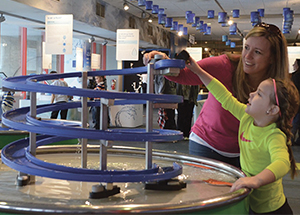What’s in Your Water?
Water, water everywhere. It makes a person think.
 The University of Pittsburgh’s Kyle Bibby thinks more about it than most, focusing on understanding the presence, ecology, and diversity of microorganisms—such as viruses and bacteria—in an environmental engineering context, like a city’s water and sewer system.
The University of Pittsburgh’s Kyle Bibby thinks more about it than most, focusing on understanding the presence, ecology, and diversity of microorganisms—such as viruses and bacteria—in an environmental engineering context, like a city’s water and sewer system.
In addition to his academic work, Bibby is keen on education. To meld these interests and to find out which microorganisms reside in the city’s drinking water, Bibby started the Pittsburgh Water Microbiome Project. It’s worth noting that such microbes are typically safe for human consumption from managed water supplies.
Bibby, assistant professor of civil and environmental engineering in Pitt’s Swanson School of Engineering, enlisted students from Pittsburgh Public Schools’ Pittsburgh Gifted Center. Under the guidance of fifth- and sixth-grade teacher Thomas Nash, students took bacteria testing kits home, collected water from their kitchen taps, and returned it to Bibby, whose undergraduate students processed the samples.
 The experience didn’t end there. As Bibby discovered during the project, the Carnegie Science Center was planning a new permanent exhibit, which opened last month, called H2Oh! Why Our Rivers Matter.
The experience didn’t end there. As Bibby discovered during the project, the Carnegie Science Center was planning a new permanent exhibit, which opened last month, called H2Oh! Why Our Rivers Matter.
It was a natural fit.
Bibby’s microbiome project is housed in the “Field Station” portion of the exhibit. Visitors can interact with a touchscreen map of all the sampling locations. A tap here reveals which microbes, broken down proportionally, dwell in a particular area’s water. A tap there reveals information about a particular bacterium. (Some samples have shown, for example, the presence of Leptospirillum, an iron-eater that, over decades, can eat away at water pipes, making them more likely to rupture.)
Bibby says he hopes this “citizen science” project will not only inform but show participants and visitors that science is everywhere, and they can do it, too. This, he hopes, will encourage young people to enter the STEM (science, technology, engineering, and mathematics) professions.
“Students who have had the opportunity to have real world STEM experience are much more likely to get involved and stay involved in a STEM field,” he says.
As Bibby and Nash’s students continue to collect samples, new data will be periodically added to the exhibit over the course of its five- to seven-year run. Bibby also plans to analyze the data and publish an article in a scientific journal.
Other Stories From This Issue
On the Freedom Road

Follow a group of Pitt students on the Returning to the Roots of Civil Rights bus tour, a nine-day, 2,300-mile journey crisscrossing five states.
Day 1: The Awakening
Day 2: Deep Impressions
Day 3: Music, Montgomery, and More
Day 4: Looking Back, Looking Forward
Day 5: Learning to Remember
Day 6: The Mountaintop
Day 7: Slavery and Beyond
Day 8: Lessons to Bring Home
Day 9: Final Lessons

